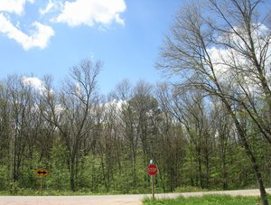Name Change for a Familiar Pest

The Entomological Society of America announced the Spongy Moth as the new common name for the invasive species formerly known as the Gypsy Moth. The name - derived from the name used in France and French-speaking Canada, “Spongieuse” - refers to the moth's sponge-like egg masses.
Should I Report a Spongy Moth (Formerly Gypsy Moth) Infestation?
 Yes! Report all infestations to the program coordinator at the Oakland County Michigan State University (MSU) Extension office. For more information, please contact the Oakland MSU Extension Moth Hotline at (248) 858-0887.
Yes! Report all infestations to the program coordinator at the Oakland County Michigan State University (MSU) Extension office. For more information, please contact the Oakland MSU Extension Moth Hotline at (248) 858-0887.
Oakland County is working to slow and mitigate the spread of invasive moths such as the Spongy Moth which as caterpillars can defoliate trees and entire forests. Working with the Oakland County MSU Extension office means that Bloomfield Township will no longer have the need to contract out Spongy Moth management throughout Bloomfield Township. The newly formed program will be administered by the Oakland County MSU Extension Program.
What is Spongy Moth?
Spongy Moth, formerly known as gypsy moth, is a foreign pest with few native predators to keep populations in check in the United States. It was introduced to Massachusetts in 1869 and has spread across the much of the northeast. Spongy Moth outbreaks began to occur in the lower peninsula of Michigan in the mid-1980’s. Caterpillars feed on tree leaves, preferring those of oak, aspen, poplar and birch but will feed on over 500 types plants throughout the summer. Large populations can defoliate entire wooded areas. Caterpillars in large numbers (and their waste, frass) are a nuisance in residential areas. Spongy Moth cannot be eradicated, but they can be suppressed to tolerable levels.
What is the Spongy Moth Life Cycle?
The Spongy Moth life cycle has four main stages: egg, caterpillar, pupae and moth.
 Egg Stage – August to April
Egg Stage – August to April
In mid-August, after mating with the male moths, the females lay their eggs in masses. Egg masses are generally firm, oval shaped, about the size of a quarter and buff or tan colored. Egg masses are laid on any surface such as tree bark, rocks, woodpiles, decks, buildings; and outdoor equipment such as car wheel wells, travel trailers, boats and anything else exposed to the outdoors. Since Spongy Moth complete only one life cycle per year, eggs laid in mid-August do not hatch until spring.
Caterpillar – Early May into July
 The eggs hatch into caterpillars in late April or early May. Hatch date is directly affected by weather. The colder the spring, the later the eggs hatch. A healthy egg mass can hold 1,000 eggs, although the average is probably between 300 and 500. Once the eggs hatch the caterpillars will remain on the egg mass for a few days before they leave to feed. In its short lifetime a caterpillar can eat one square meter of leaves. Mature caterpillars are about 2 inches in length with long hairs grouped in bundles. They have 5 pairs of blue dots and 6 pairs of red dots running down their backs. Their heads are black with yellow markings.
The eggs hatch into caterpillars in late April or early May. Hatch date is directly affected by weather. The colder the spring, the later the eggs hatch. A healthy egg mass can hold 1,000 eggs, although the average is probably between 300 and 500. Once the eggs hatch the caterpillars will remain on the egg mass for a few days before they leave to feed. In its short lifetime a caterpillar can eat one square meter of leaves. Mature caterpillars are about 2 inches in length with long hairs grouped in bundles. They have 5 pairs of blue dots and 6 pairs of red dots running down their backs. Their heads are black with yellow markings.
Pupae – July and Early August
In mid-July to mid-August, mature caterpillars stop feeding and weave silk around their bodies to form a hard-brown shell or cocoon. In this pupae stage, caterpillars start their metamorphosis or change into the moth stage of the life cycle. This process takes about two weeks.
Moth – Mid July to Early August

Moths, the adult stage of the life cycle, emerge from the pupal cases in mid-August. The moths do not eat and they live only for a week. Female moths have white wings with brown chevron or ‘V-shaped’ markings and do not fly. Male moths have smaller brown wings and are able to fly. Attracted to a pheromone emitted by the female, the males can fertilize several females before dying. Female moths lay egg masses that remain dormant until spring.
FREQUENTLY ASKED QUESTIONS
How are Spongy Moth populations suppressed?
The main defense is an application of Bacillus thuringiensis var. kurstaki (Btk), used to reduce high populations of gypsy moth caterpillars at sites that meet certain guidelines for treatment. Typically, Btk is sprayed over large areas of land by plane. However, landscaping and tree care companies can provide ground-based spraying of specific trees. Btk is a naturally occurring bacterium found in the soil and is not harmful to pets, birds, fish, plants, beneficial insects or humans. Btk specifically targets only caterpillars of a certain age. It is applied when the caterpillars are young (usually in May) to insure the greatest impact in reducing numbers. Alternative mechanical techniques, such as tree banding, egg mass scraping and hormone traps to help reduce populations.
What Homeowners Can Do to Reduce the Spongy Moth Population
How do Spongy Moth travel?
Caterpillars hang in trees on a silk strands and can be carried a great distance by the wind. Humans also move egg masses or pupal cases on travel trailers, firewood or cars.
How do I know if I have Spongy Moth?
Male moths are brown with dark markings and female moths are white with black markings.

It’s not a Spongy Moth if it builds a cottony nest or web in trees; looks like a white moth that flies; is larger than a 50-cent piece or colorful; is a caterpillar with long stripes on its back or sides; or flies in springtime.
You can also use the Oakland County MSU Extension diagnostic facility. There is a small fee for some services. Contact the Oakland MSU Extension Moth Hotline at (248) 858-0887.
What does Spongy Moth damage look like?
Spongy Moth caterpillars feed on tree leaves creating ‘swiss cheese’ type holes. They do not cause premature leaf drop, browning or curling of leaves. They do not make a web or tent in trees. In addition to damage to the trees, Spongy Moth caterpillars can be a nuisance if populations are high enough. Caterpillars and their frass (feces) can drop down from trees on to sidewalks, driveways, yards, porches and vehicles. The hairs on the caterpillars can cause irritation or an allergic reaction to bare skin. Frass can stain surfaces especially if it is rained on or becomes wet.


What happens when trees are defoliated?
Trees defoliated more than 40% become stressed by using next year’s energy reserves to grow new leaves during the same season. Healthy trees may withstand several years of defoliation. Evergreens are unable to replace their needles and may die when defoliated. Keep trees watered and fertilized to reduce any stress.

Should I report a Lymantria Dispar infestation?
Yes! Report all infestations to the program coordinator at the Oakland County MSU Extension office. For more information, please contact Oakland MSU Extension Moth Hotline (248) 858-0887.
What Can I Do?
As a resident of the Township we need your help! Search for Spongy Moth egg masses on trees, firewood and outdoor furniture. Scrape egg masses into a bucket or similar container filled with soapy water, or burn or bury the egg masses. Don’t leave eggs or bits of egg mass on the ground – those eggs can often hatch the following spring.
Band your trees with barrier or hiding bands to reduce the number of caterpillars. This is also a good way to monitor growth of the population.Band Your Trees
Encourage Natural Enemies, parasites and predators of the Spongy Moth. These include several mammals, birds and predaceous insects. Be cautious of the chemicals used around your home which may affect some of the natural enemies.
Clean up hiding places for the Spongy Moth. Dispose of unused equipment stored outside and burn wood stored in wood piles.
Take care of your trees. Trees that are not stressed will have a better chance of surviving your next Spongy Moth infestation.
Overcrowded trees competed for light, nutrients, and water. Thin an overcrowded woodlot during periods of low Spongy Moth. Lack of water and nutrients will stress a tree. Fertilize your trees and water during dry periods. Plant trees that the Spongy Moth usually avoid. These include ash, pear, locust, juniper, spruce, catalpa and ginkgo.
For More Information
If you have questions about the material presented here, please visit the links below for more information on Spongy Moth.
Michigan State University Integrated Pest Management
Lymantria Dispar Outbreaks in Michigan
Lymantria Dispar Outbreaks May Be Contained with The Help of a Little Fungus
Lymantria Dispar Is A Threat to Our Trees and Shrubs.
What Can You Do to Manage Lymantria Dispar In Your Landscape?
Lymantria Dispar Populations Explode in Michigan
Comparison of the Eastern Tent Caterpillar, Forest Tent Caterpillar, and Lymantria Dispar
Btk: One Management Option for Lymantria Dispar
Surveying Lymantria Dispar Egg Masses to Forecast Next Year’s Population
Dealing with Lymantria Dispar Around Your Home or Property
The Entomological Society of America.
New Name, Familiar Pest Webinar 9 a.m. Thursday, April 14

